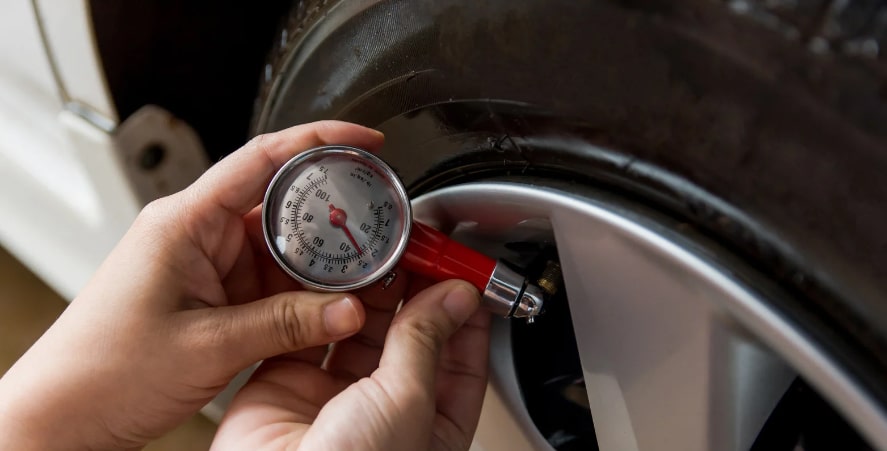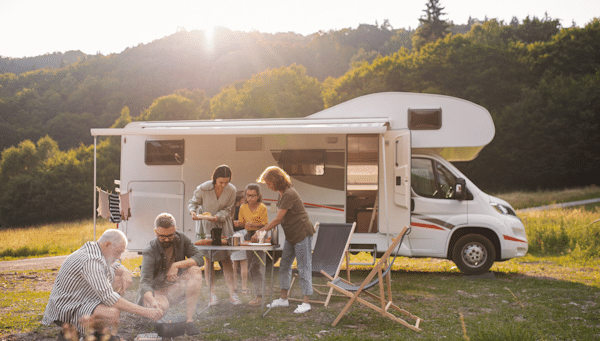
by California Casualty | Helpful Tips, Safety |
It’s the perfect time of year to open the windows and enjoy the fresh air. Yet open windows can be a hidden danger for kids. It’s easier than you may think for young ones to slip through and fall. Fortunately, window accidents are preventable with the right safety measures. This season, keep your home and windows secure for your little ones.
What makes windows dangerous?
Children are naturally curious. They like to climb and explore. Window screens are designed to keep bugs out, but not hold children in. Even a small child has the strength to push out a screen. Children under the age of 5 are especially at risk if this happens. Their heads make up a larger percentage of their bodies as compared to adults, so they are likely to fall headfirst.
Some windows are more enticing or easier to access for young kids:
- Windows with deep windowsills or built-in window seats
- Windows that overlook a play area or place of interest to a child
- Windows that are near furnishings where children can climb to reach them
- Windows that do not have safeguards and do not lock
Types of Windows
You want to be concerned about any type of window that can open.
- Single hung windows have a bottom sash that opens.
- Double hung windows have bottom and top sashes that open.
- Bay windows often have side angled panels that can open.
- Casement windows swing open to the side, often using a hand crank.
- Awning windows swing up in a similar way to casement vehicles.
- Horizontal sliding windows open by sliding to the side.
- Picture windows generally do not open.
Window Safety Devices
You can buy safety devices that limit or block window openings at your local hardware or home store and online. Look for ones that are compliant with ASTM International specifications. ASTM stands for the American Society for Testing and Materials, and it establishes standards for a wide range of products, including window fall prevention devices. Place these devices on every window that can open, including first floor windows. That still can be a significant fall for a young child.
Window Guards
Window guards block the opening of a window. There are two basic kinds, each of which needs to be properly fitted.
- Fall prevention window guards use closely spaced bars that are secured to the window frame. Made of durable material such as steel, these guards may be installed with screws or bolts. They usually have a release mechanism for quick access to disable them.
- Fall prevention screens are different from standard window screens that protect from bugs. These screens are designed to withstand as much as 60 lbs. of pressure or more.
Window Stops
Window stops restrict windows from opening fully. Make sure to set them so windows open a maximum of 4 inches.
Pro Tip: Once you install a safety device, practice removing it, so you’ll know how to do so if you need to exit via the window in an emergency.
Window Cords
Young children also can be entangled and strangled by window cords. Remove the cords or keep them well out of reach.
- Retrofit old cords with cord stops or cut looped cords and replace with tassel ends.
- Switch to cordless blinds for your window treatments.
Other Window Safety Tips
- Close and lock windows when an adult is not in the room to supervise.
- If you have windows that can open at the bottom and the top, open them only at the top to help prevent falls.
- Move furniture and cribs away from windows so kids cannot climb on them. Make sure that furniture is a minimum of 3 feet from windows.
- Keep your eyes on children when the windows are open. Make sure they do not get too close.
- Teach children not to play near windows, not to lean on windows, and to always ask permission before opening a window.
- Regularly inspect and repair broken windows as soon as possible.
- If you have a hard surface outside underneath your windows, consider adding soft grass, bushes or other landscaping that could cushion a fall. This could ultimately help to lessen an injury.
- Open, unsecured windows can also be a danger to pets. Keep your fur babies safely away from open windows and balconies.
- Discuss window safety with your child’s daycare, babysitter and family members. Make sure everyone is aware of the safety precautions to take.
This article is furnished by California Casualty, providing auto and home insurance to educators, law enforcement officers, firefighters, and nurses. Get a quote at 1.866.704.8614 or www.calcas.com.

by California Casualty | Auto Insurance Info, Helpful Tips, Safety, Travel |
There are four things standing between you and the pavement when you drive—your tires. Keeping them in good shape is key to staying safe on the road. Whether you’re gearing up for a long drive or just your daily commute, knowing how to check your tire pressure is a small step that can make a big difference.
That’s because the right tire pressure can have some far-reaching impacts:
- A smoother ride and better handling
- Better fuel efficiency
- Improved stopping distance
- A longer lifespan for your tires
What’s the right pressure?
If you drive a passenger car, your tire pressure is likely between 32 to 35 pounds per square inch (psi). SUVs and trucks require a higher psi. Here’s how to find the exact number:
- Open your driver’s side door.
- Look along the doorjamb for a sticker. It should display the pressure (including whether you need specific pressures for front and rear tires and your spare).
- You can also find the recommended pressure in your owner’s manual.
- Importantly, do not go by the number that is on the sidewall of your tires. That is the maximum pressure allowed.
Dangers of Overinflating or Underinflating Tires
You want the right amount of pressure in your tires, not too much and not too little.
- Overinflating causes the center of the tire’s tread to wear faster. It also decreases traction and your tire’s ability to absorb impacts.
- Underinflating causes the outer edges to wear faster. Your car may pull or drift to the side.
- Both overinflation and underinflation cause uneven wear, which reduces your tires’ lifespan. At the very least, it will require you to purchase a new set sooner than normal; at the worst, it could cause a
Start with the Right Tools
Now that you know the basics about tire pressure, you’ll want to gather the right tools. You need a tire pressure gauge to start. While you could use one built into an air machine at a gas station, those aren’t always the most accurate. It’s always good to have your own, which you can use at home and anywhere. You can purchase a gauge at an auto supply or hardware store. You will likely have a choice of three kinds:
- Stick gauge: Usually the most inexpensive option, this type of gauge resembles a pen. It has a small bar that pushes out to show the reading.
- Dial gauge: This type of gauge has a round dial that looks like a clock face or compass. The needle will stop at the number to show the reading.
- Digital gauge: This gauge has an LCD display showing the pressure in numbers. However, it needs batteries to operate and when they run out, you will need to replace them.
Optional but handy:
You can buy a portable air compressor to allow you to fill your tires anywhere and not just at a gas station’s air compressor kiosk. These vary from manual hand-operated or foot pumps to those you can plug into your car’s battery or a 12V power port. You will pay more for one with a built-in gauge, which can be helpful. If you are considering a purchase, look for one where you can put in the proper pressure and the unit will shut off when it reaches that number.
How to Check Pressure
You should check your tires’ pressure monthly or whenever there are changes in weather that could affect them.
- Start with a “cold” tire which is when a vehicle has been parked for 3 hours or more, or one that has been driven less than a mile at moderate speed. Tires heat up when they’re driven and that will increase the air pressure, and you won’t get an accurate reading.
- Remove the screw-off cap on your tire’s air valve. Put it someplace safe where you will not lose it.
- Place your tire gauge over the valve and push it into the stem. If you hear air escaping, continue to press it in until that stops.
- Check the reading on your tire gauge. Note that some gauges need to be in the tire’s valve for the reading; others may be removed.
- If the reading matches the recommended pressure, screw the cap back on. If not, take the next steps to add air or take it out.
- Repeat for each tire.
- If you can access your spare, do it for that one as well. It will be helpful to have a spare ready to go should you need to change a tire.
How to Add Air
You can find air compressors at most gas stations, and they are often free or a minimal charge.
- Park so the tire in need is closest to the machine so the cord will reach.
- Read the directions on the compressor before paying (if there is a cost). Once you pay, you should hear the machine turn on.
- Remove the screw-on cap on the tire valve. Put it somewhere safe.
- Press the hose nozzle on the stem of the valve. You should see the tire inflating and the numbers on the air machine going up.
- If you hear a hissing noise, you’re letting air out. Push the nozzle in to attach it properly.
- Check the pressure with your gauge.
- Repeat until you have the right number. Replace the cap.
If you had to drive a few miles to get to a gas station with air, your tires will be hotter than normal. Remember your base “cold tire” reading and calculate the difference between that and the ideal pressure. Add that amount. (For example, your tires needed to be 33 psi but were only at 31 psi in your driveway, you will want to add 2 psi.) Then, check again later after the tires have been sitting for 3 hours to make sure it’s the right amount.
How to Remove Air
You don’t need an air machine to let air out. You just need a flathead screwdriver.
- Take the cap off the valve.
- Press the end of the screwdriver into the center of the valve stem.
- Hold it for a few seconds. Listen for air escaping.
- Check the pressure and repeat as necessary.
Pressure Changes by Season
As the weather changes, you will notice corresponding changes in your tire pressure. That’s because air expands as it gets hotter, which raises the pressure. It contracts as it gets colder, which lowers it. In cold weather, tire pressure can decrease about 1 psi for every 10-degree drop in temperature. That’s why it’s important to check your tire pressure when the weather changes, in extreme heat and cold, and adjust as needed.
Note that your car’s tire pressure light activates when there’s a temperature change as well as a small leak. The light goes on when the pressure is about 25% below the recommended level.
A Word About Air vs. Nitrogen
When it comes to keeping your tires inflated, you have a choice: air or nitrogen. If you have nitrogen in your tires, you will need to revisit a nitrogen provider to fill your tires. You will not be able to fill them at air kiosks at a gas station.
Keeping the right tire pressure will help extend the life of your tires. Keeping your vehicle well maintained will help extend its life. Finally, protect it with the right insurance coverage. This will give you peace of mind for your journeys ahead. Safe travels.
This article is furnished by California Casualty, providing auto and home insurance to educators, law enforcement officers, firefighters, and nurses. Get a quote at 1.866.704.8614 or www.calcas.com.

by California Casualty | Auto Insurance Info, Helpful Tips, Safety, Travel |
From traffic jams to reckless drivers, it can be stressful on the road. When you’re also juggling life’s daily demands, the stresses can leave you frazzled behind the wheel. Stressed driving not only affects your personal wellbeing, but it poses risks to road safety. Here’s how to bring back a sense of calm and control — and crush your daily commute.
How Stress Affects the Brain
Stress is the body’s reaction to potential threats. It affects your frontal lobe, where you set goals, make plans, and keep your emotions in control. It also impacts the hippocampus, which stores your memories. Importantly, stress causes a chemical reaction known as “fight or flight.” When you’re stuck in traffic or upset about being cut off, there’s often nowhere to go. That’s when your emotions can turn to road rage.
Driving While Stressed
Stress can cause mental and physical symptoms that affect not only how you feel but how you drive. Recognizing these symptoms can help you take steps to manage your stress.
Physical Signs of Stress
You may notice your heart beating faster or your palms getting sweaty. Those are common symptoms of stress. You also may feel muscle tension in your neck, shoulders and back. Biting nails, tapping fingers, and other repetitive motions also are indicators of stress. You may even get tension headaches or feel unusually tired after a short drive.
Distracted Driving
Stress often leaves you distracted. When you’re worrying about traffic, other drivers, or being late, you’re not focusing your attention fully on the road. Your concentration is reduced. You could have difficulty with decision-making and slower reaction times as a result. If you’re sitting in traffic and you pick up your cell phone to complain about the stress, that adds another level of distraction.
Irritability
When you are stressed, you may feel easily annoyed or angered by minor inconveniences. You start to engage in aggressive driving behaviors such as tailgating, speeding or frequent lane changes. This can escalate to emotions that are hard to control.
Tips to Reduce Your Stress While Driving
Stress may be unavoidable, but you can take steps that help you manage it. Follow these tips to reduce your stress behind the wheel.
- Plan ahead. Know the route you’re taking and plan your journey in advance. Be aware of alternate routes should you encounter traffic or road closures. Bringing the kids along? Pack books, snacks, and games to keep them entertained so that they do not add stress to your trip.
- Leave early. Allowing extra time for your journey can help you better handle the unexpected, such as traffic, weather, or detours. When you leave early, you are less likely to worry about being late.
- Set your playlist. Research shows that listening to music can enhance immune system function and lower levels of the stress hormone cortisol. Create a mindful playlist and avoid news or any content that might stress you out. Sing along to your favorite tunes for a mood boost.
- Adjust your posture. Improving your posture can increase oxygen flow, decrease tension in the neck and shoulders, and reduce physical discomfort. Adjust your seat and mirrors to maintain a comfortable and relaxed driving position.
- Breathe. Inhaling through your nose and into your belly is a proven way to reduce stress. Deep breathing sends a calming message to your brain, helping you relax. If you’re feeling stressed, try this breathing exercise: breathe in for a count of 8, contract one muscle group (like your neck and shoulders), then exhale and relax. Repeat for muscle groups in your neck, shoulders, and back as needed.
- Change your perspective. Managing your thoughts can help control your emotions. Instead of getting angry at a driver who cuts you off, think, “I’m glad no one got hurt.” Don’t let a stranger’s actions affect your mood.
- Pull over if needed. If stress becomes overwhelming while driving, don’t risk it. Find a safe location to pull over and take a break until you feel calmer.
- Stay fueled. Keep your car filled with gas to avoid the added stress of running low. When planning your trip, make sure you know when you plan to fuel up.
- Maintain and insure your vehicle. Make sure your vehicle is well maintained so it is less likely to break down and leave you stranded. In addition, protect your vehicle with the right insurance coverage. This will give you peace of mind for your journeys ahead. Safe travels.
This article is furnished by California Casualty, providing auto and home insurance to education professionals, law enforcement officers, firefighters, and nurses. Get a quote at 1.866.704.8614 or www.calcas.com.

by California Casualty | Helpful Tips, Safety, Travel |
You’re ready to hit the road in your RV. Whether you’re an experienced RVer or a newcomer to the lifestyle, protecting your vehicle from fire hazards can mean the difference between a dream vacation and a disaster.
As your home on wheels, your RV presents greater fire dangers than a standard vehicle. With features like kitchens and curtains, there are more opportunities for things to go up in flames. There also are electrical and mechanical components that can present a fire risk if not properly maintained. Here’s what you need to know to keep your family safe.
Electrical Systems
RVs use both AC (alternating current) and DC (direct current) power. AC operates your appliances and outlets while DC powers your engine and battery. Solar panels also are gaining popularity and can be configured to provide either AC or DC power.
- Bumps and vibrations can loosen connections. Check your electrical systems regularly to make sure connections are secure.
- Check for frayed wires and damaged outlets. Never use wires or outlets that are compromised. Replace as needed.
- If the circuit breaker shuts off power to a certain circuit, it’s probably overloaded. Other signs include lights that flicker or buzzing noises from outlets and switches. Consult a professional to ensure that you don’t have an overloaded circuit.
- While power strips are generally safe for small wattage appliances (charging cell phones or table lamps), they may not do well with high wattage. They also cannot handle continuous loads required by space heaters. Power strips can overheat and ignite combustible material in the walls.
- Don’t cover electric cords with rugs or carpets.
- Only use extension cords rated for outdoor use. If left out overnight, cords can get wet.
- If you have an electrically charged fire, don’t use water to extinguish it. Use a fire extinguisher approved for type C fires.
Propane Appliances
Propane commonly powers stoves, refrigerators and water heaters in your RV. It’s an efficient fuel that also can be dangerous if mishandled. Propane leaks can cause fires and explosions.
- Regularly inspect your propane tanks and lines for leaks or any issues. Do not use tanks and lines that have been damaged.
- Always store propane tanks in an upright position in a well-ventilated area away from a heat source.
- Turn off propane-powered appliances when not in use.
- Make sure propane-powered appliances are off when you are in motion. Gasoline vapor and an open flame are not a good combination. Also, many propane appliances need to be level and roads are not.
- Get your RV LP-certified. A licensed liquid propane technician can inspect and test your propane system.
- Consider switching to an induction cooktop and electric fridge to reduce the use of propane.
Cooking Accidents
The small space and low ceilings in most RVs make it more dangerous to cook there than at home. Most RVs use propane stove tops, which can be an added risk.
- Properly vent fuel-burning appliances. Never operate them in an enclosed space such as a bathroom, bedroom or storage area. Turn on the exhaust fan, open a window, or cook outside.
- Keep flammable materials away from the cooking area.
- Never leave cooking appliances unattended while preparing meals.
- Turn off appliances before leaving the RV.
- Check and maintain your appliances regularly. Keep them clean; make sure there are no loose or chewed wires.
- Do not use cooking appliances to heat your RV. That could create a dangerous situation where there’s insufficient oxygen in a small space.
Pro Tip: For curtains, choose natural fabrics (cotton, hemp) which are less flammable than polyester.
Engine & Mechanical
Your RV is not just a home; it’s also a vehicle. That means it’s equally important to keep the engine and mechanical systems well maintained.
- Check brakes and bearings. Improperly adjusted trailer brakes can overheat. Wheel bearings also can overheat if not properly greased.
- Make sure there are no leaks. Place a piece of cardboard under the RVs engine for a few nights to see if you have a leak. Repair any engine or transmission leak as soon as possible. Transmission fluid is highly flammable.
- Check the battery. Most RVs use lead acid batteries which must be ventilated, or they can give off dangerous gasses. Make sure the battery is open to the outside by vent or hose.
- Trailer chains that are too long can drag on the road and create sparks. Adjust them as needed. Just one spark can cause a fire.
- Improperly inflated tires can overheat and cause a fire. It also can cause the tire to fail.
- Exhaust systems can become very hot. If they have contact with flammable dry grass, it could ignite.
Safety Gear
Outfit your RV with the right safety gear so you’re alerted to any potential emergency, and you can act quickly.
- Place smoke alarms and carbon monoxide detectors in every sleeping area.
- Check the alarms and detectors, and switch batteries every spring and fall.
- Fire extinguishers should be in easy to reach areas, for example near the door. Get one that is rated type A (for wood, plastics, cloth) and type B (for liquid fuel like grease, oil, stove and motor fuel) and type C (for electric fires).
- Test your emergency exits including windows that can be used as an escape route. Make sure you have at least two ways out and nothing is blocking those paths.
If you smell gas:
- Extinguish all open flames pilot lights, lamps.
- Shut off the gas supply.
- Do not turn on an electrical switch as that can create a spark that causes an explosion.
- Remember to evacuate first. Call the fire department, and then try to put out the fire.
If you’re renting an RV:
Remember to do your due diligence to make sure your RV is safe.
- Choose a newer model. Older models of RVs have fewer and less advanced safety measures. Older engines and equipment also are more likely to fail.
- Ask the last time it was inspected.
- Look at the fire extinguisher expiration date.
- Look at the indication lights on the propane system and carbon monoxide system to see that they’re working properly.
- Check smoke alarms and carbon monoxide detectors.
- If you suspect an issue, address it before you sign the paperwork.
Finally, if you’re driving your own RV, make sure it is fully protected by insurance for your own peace of mind. Safe travels!
This article is furnished by California Casualty, providing auto and home insurance to educators, law enforcement officers, firefighters, and nurses. Get a quote at 1.866.704.8614 or www.calcas.com.

by California Casualty | Helpful Tips, Safety |
When there’s a wildfire near your home, every second counts. Leaving quickly can help you steer clear of thick smoke, dangerous conditions, and even traffic jams as everyone heads to safety. The key to a quick exit lies in preparation—having a well-thought-out plan and essential items ready to go.
Pre-Evacuation Prep
Follow this general guide to know what to pack. Keep this as a checklist and refer to it as you assemble everything that you need.
Food and Water
- Put together a 3-day supply of food for everyone in your family (unless you’re going to a relative’s or friend’s home who lives far away from the fire zone).
- Bring 3 gallons of water per person.
- Pack utensils and bowls, as you don’t know what might be available in emergency shelters.
Pet Supplies
- Pack kibble, bowls and bring water for pets.
- Bring a leash, collar, pet bed, crate or carrier, litter box, and litter as needed for your pet. Include treats and toys.
- Pack pet medications.
- Check that your pet’s microchip details are up to date.
- Bring contact information for your pet’s vet and/or your pet’s vaccine records.
Medicine and Hygiene
- Bring prescription medications and any medicines that your family may use on a regular basis: pain relievers, allergy medicines, contact lenses and solution, inhalers, etc.
- Pack hygiene items such as shampoo, soap, deodorant, toothbrushes, toothpaste, disposable razors, shaving cream, and towels.
- For infants and toddlers, bring diapers and baby wipes.
Safety
- Keep a first aid kit in your car should you need it.
- Include N95 masks if available to limit your exposure to smoke.
- Pack flashlights and batteries.
Clothing and Bedding
- Pack for practicality and safety. Layer clothes for a range of temperatures. Don’t forget PJs, socks, and underwear, as well as a raincoat or all-weather jacket.
- Comfortable, closed toed shoes work best in emergency situations.
- Bring sleeping bags, pillows and blankets. Include a portable crib for infants and toddlers.
Electronics
- Bring chargers for smartphones, laptops, and devices. Include a solar charger if you have one.
- Keep your devices well charged before you leave so you won’t have to search for a place to charge.
- Pack a battery powered radio and spare batteries in case the power goes out.
Special items
- There are some things you that you cannot replace. If you have the room, and they are easy to carry, plan to bring up to 3-5 of these special items.
- Your planning time is a good time to do a home inventory of all your possessions. Take pictures and notes of big items. This will help if your home is partially or completely destroyed by a wildfire, and you need to file a claim.
Documents
- Prepare a binder with key documents: mortgage or rental agreement, insurance policies, birth certificates, passports, bank information, and investments.
- Make sure your wallet or purse has your driver’s license, registration, health insurance cards, debit and credit cards.
- Complete a cell phone list for neighbors, family. Designate a person outside the wildfire area who can be the main contact should family members get separated or have trouble with cell service.
- Make copies of everything and keep them in a secure password protected digital space.
Prepare Your Home & Vehicle
During a wildfire, embers can travel quickly and ignite your home and property. Here are some steps to take to prepare your home and vehicle.
- Keep the vehicle that you’ll be leaving in fully gassed and well maintained. Park it in the direction it needs to go when you leave.
- Make sure that you know how to manually open the garage door in case you lose power.
- Make sure everyone in the household knows what to do to quickly evacuate.
- Close all windows. Close all interior doors.
- Take down flammable window treatments like curtains and store them out of the way.
- Turn off the gas and pilot lights. Shut off propane tanks.
- Turn off your air conditioning.
- Leave lights on to allow firefighters to see your home in the dark.
- Bring potentially flammable outside furnishings, toys and doormats inside or place them in your pool.
- Attach garden hoses to outside taps for firefighters to use. Placed filled buckets of water around your home.
- Listen to first responders and be ready to act when they recommend evacuation.
Pro Tip: California Casualty policyholders may be able to get immediate help if they are evacuated by fire. Evacuation expenses, such as hotel or other temporary housing, and meals are reimbursable with most policies.
Review your wildfire evacuation plan often. Keep it updated as your family grows and needs change. Finally, protect your home with the right insurance for added peace of mind.
This article is furnished by California Casualty, providing auto and home insurance to educators, law enforcement officers, firefighters, and nurses. Get a quote at 1.866.704.8614 or www.calcas.com.

by California Casualty | Helpful Tips, Safety |
It’s a beautiful night to sit around the fire pit. The flicker of the flames and the crackling of the fire create the perfect backdrop for relaxation and conversation. Yet the scene can quickly turn dangerous without the right precautions.
Each year, fire pits send thousands of people to the emergency room. Young children and pets are especially vulnerable. Fire pits can also pose a significant fire hazard for your property, igniting leaves and grass, wooden structures and even your home. Follow these 10 fire pit safety tips to help keep everyone and everything safe.
1. Choose the right location.
Place your fire pit at least 10 to 20 feet away from other structures. Keep it away from low hanging branches above. There should be a minimum of 12 feet between your fire pit and tree branches. Never set up below power lines or string lights, which can create immediate danger if sparks fly. Don’t put your fire pit under a building overhang or in an enclosed area. That could cause a buildup of smoke, carbon monoxide and harmful gases that can be deadly.
2. Select a safe, stable surface.
Avoid putting your fire pit directly on the grass or on a wood deck. Instead place your pit on brick, concrete pavers, gravel or sand. Alternatively, you can buy pit pads and heat shields for underneath your pit, as well as pedestals. Surround your pit with crushed stone, sand or brick for added protection.
3. Choose the right fuel.
Soft woods like pine burn less efficiently, and spark more. It’s better to buy seasoned hardwood kindling and logs. You also could use fallen branches from trees in your yard. Do not, however, use construction lumber like pressure treated wood, plywood or chemically treated pallets. These woods will emit toxic fumes when they burn. So will trash and plastic. Never start a fire with lighter fluid or gasoline; that will create a burst of flames and can even release toxic gas or cause an explosion. Don’t throw leaves into the fire. They are light and can be carried by the wind. Finally, when tending to the fire, make sure your sleeves are rolled up and your hair is tied back. Use heat-proof gloves, a metal fire poker or safe long handled tongs.
4. Check the wind conditions.
Don’t use your fire pit on windy days. Wind can easily blow sparks around to surrounding brush. Use a screen to contain sparks and large embers. If your fire pit is portable, place it in a location with a natural windbreak before you start the fire. Always heed “no burn” alerts from your local municipality. If they say conditions are unsafe for a fire, it’s too risky to chance it.
5. Keep chairs far enough away.
Carefully place your seats around the fire pit. If you’re too close, your hair or clothes could catch fire. Stay 3-4 feet away from wood burning fires and 2-3 feet away from gas fires. Keep children 3-10 feet away from the flames. If a light breeze is blowing, have guests sit upwind so they can keep clear of the smoke.
6. Supervise children and pets.
Children and pets don’t understand the dangers of fires. They are naturally curious. Teach children the rules about not touching the fire or fire pit and not throwing things into it. Make sure they stay sufficiently away and remind them if they venture closer. Consider barriers or designated areas for both children and pets. Make sure there is a responsible adult who always has eyes on them.
7. Drink responsibly.
Fire and alcohol are not a good combination. Alcohol is highly flammable, and overindulgence can affect our judgment, coordination, and reflexes. If you are going to serve alcohol around the fire pit, have a designated nondrinker overseeing the flames. Keep everyone a safe distance away. You also may consider a smokeless fire pit which could add a layer of safety.Never leave a fire unattended. Extinguish it completely when you are done.
8. Never leave a fire unattended. Extinguish it completely when you are done.
Sparks can fly and fire emergencies can happen in an instant. If you must leave the area, designate a deputy to watch over your fire pit. Remember that fires are “live” for long after they seem to stop burning. Almost extinguished fires with hot ash and hidden embers have been known to cause plenty of damage. Make sure to put out the fire completely before leaving it. Pour water over live embers. Turn the logs to make sure all sides have stopped burning. Check the fire pit the next day just in case. Hover your hand over the ashes to make sure they are not still radiating heat. When it is safe to do so, use a metal shovel to dispose of ashes in a metal pail or trash can. Then wet the ashes by slowing pouring water over them.
9. Be prepared to extinguish a fire in an emergency.
Always keep a shovel, dirt/sand, and water on hand in case of an emergency. You can smother the flames by piling dirt or sand on them. You can spray water from your garden hose but don’t use a focused stream which can spread embers. Also check your manual to see if your firepit is made from a material that is water safe and won’t rust or crack. You may want to invest in a fire blanket which can be used to smother a fire. A multipurpose fire extinguisher can be used as a last resort.
10. Check your local regulations.
Some municipalities require you to get a permit for your fire pit. Due to the fire risk, some homeowners’ associations (HOAs) don’t allow fire pits. Others require an onsite inspection from a local fire official. Do your homework and find out the local rules so that you can follow them.
Finally, protect your home with the right insurance. Accidents happen despite our best precautions. Make sure you have enough coverage in the event of a fire.
This article is furnished by California Casualty, providing auto and home insurance to educators, law enforcement officers, firefighters, and nurses. Get a quote at 1.866.704.8614 or www.calcas.com.






